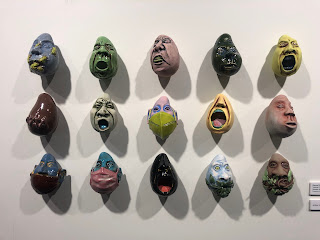 |
| Eli Ortega's Dragon (detail of textures) |
Earlier this month I wrote about my hand-building students' portraits as they were in the process of building them. They have now finished and I wanted to share the results.
Eli Ortega's dragon (side and back view)
The assignment asks students to create a portrait of person, animal, or creature from real-life or fiction. This quarter we had a dragon, a dog, a stuffed elephant, and a few people. I think the subjects made clear that this project started around Halloween, since we also had Chuckie, Leatherface, and the Phantom of the Opera, as well as Medusa.
 |
| Emily Chaidez's Chuckie sculpture (portrait) |
The students were asked to bring in an object or several photos of their subject so that they could sculpt in three dimensions. The challenge is often moving from two- to three-dimensions in their build. Students are so used to seeing flat images, or drawing flat images, that it is a challenge to represent the curves of the face accurately.
 |
| Chuckie lost his hands and feet, but I still love the stance he's in here. |
This class did not seem to have a lot of trouble, at least compared with other classes, with forming the basic shape of the. face, neck and head. A few students also chose to represent the whole body of their subject, which can lead to other complications.
 |
| Crystal Preciado's (Instagram @crys.no) stuffed elephant sculpture |
The students who chose to do whole bodies instead of busts had to contend with the position of the legs, arms, and, in some cases, trunks of their subjects. A stuffed subject, like the elephant is a pretty stable form to begin with, but human (or doll) bodies can be challenging because the bodies and limbs are so thin.
 |
| The side view of Crystal's elephan shows the length of the tusk and the width of the ears and body. |
A couple of students had some trouble with hands or feet breaking on full-body portraits. This quarter the extra challenge for all students, and one that especially impacted some students, was that we had fewer on-campus days than a "normal" Clay 1: Hand-building class. Usually that class meets 3 days a week for 2 hours. This quarter we met just 2 days a week for 2 hours and the rest of the class was online.
 |
| Phantom of the Opera by Savannah Ross (Instagram @rootbeer.rat) with its mask on. |
Students were still able to come into the studio outside of class time, but for some students, getting to campus was sometimes a challenge. Several students, including Emily (Chuckie) and Savannah (Phantom) did much of their building on their own and/or at home.
 |
| Phantom with his mask off, notice the interesting texture (can't wait to see it glazed) |
I was impressed with the students who worked from home for part of their project, not least because transporting a big heavy lump of clay can be a challenge. Evelyn (Medusa) took her work home to apply the texture to the snake hair after it was hollowed out, meaning it was lighter, but potentially more fragile.
 |
| Medusa by Evelyn Ayala-Frustos (Instagram @evelynayalafrutos) |
One of the things that I especially like to see across the range of pieces made for this project is the range of textures that students applied to their work. Evelyn's snake scale texture on the hair stands out in particular against her smooth face skin. Ashley (racing dog) and Crystal (stuffed elephant) applied soft textures to their fur/fabric. Elizabeth and Emily both have stitching in their horror move skin surfaces and Savannah's Phantom has a scarred face.
 |
| Evelyn's Medusa from the front |
The many texturs in Eli's dragon's skin are the most impressive at this stage. She did a particularly impressive job of layering textures and transitioning between different carved and applied textures. The texture markedly changes in the back behind the horns and in front of the neck.
 |
| Ashley Boroff's racing dog |
 |
| Leatherface by Elizabeth Harris |
I had the most trouble advising Elizabeth on Leatherface as I'm not familiar with the movie (I don't watch horror movies). Luckilly she had pictures to use as references, but the way the extra face is layered over the actor's face made for some odd positions and levels that contradicted what I usually advise students about proportions and depth.
 |
| Leatherface from the side really shows the depth in the eyes and the funny proportions that happen when, I guess, your subject is wearing someone else's face. |
An additional challenge of our limited on-campus time is that not all the students were able to take their photos in the school's photo booth. Most students did, but for a few I'm hoping that the glaze pictures will have a bit better lighting and contrast. I didn't share everyone's photo here, but hope that I'll be able to share a few more later.
 |
| AnaBeth Montemayor's Corpse Bride was an extra challenge to build because of that long skinny neck |































